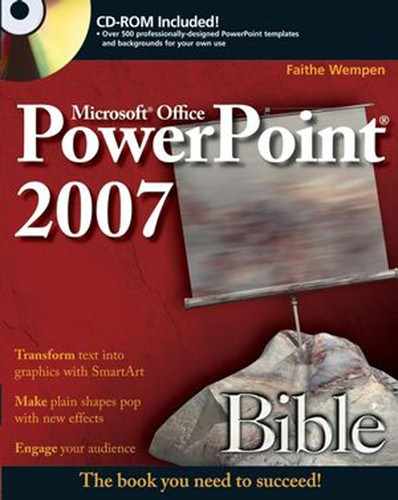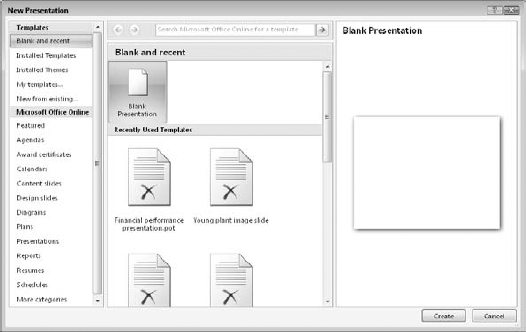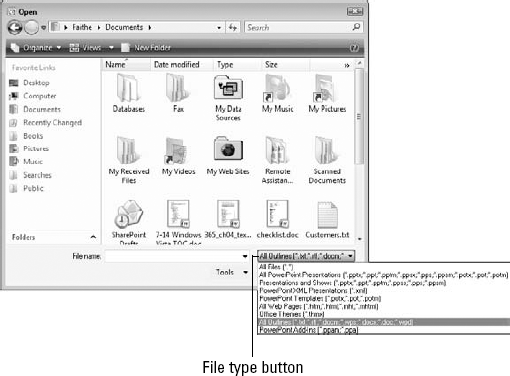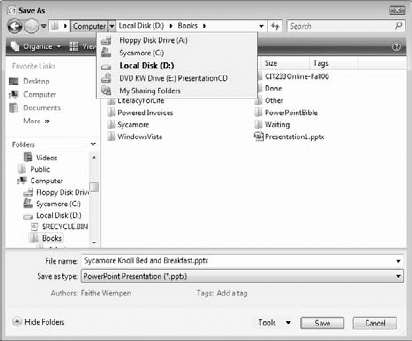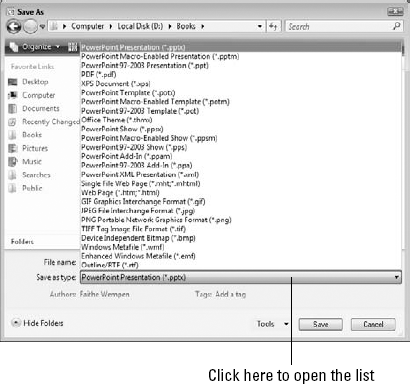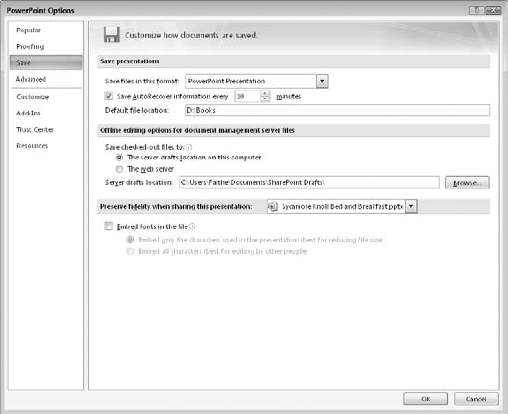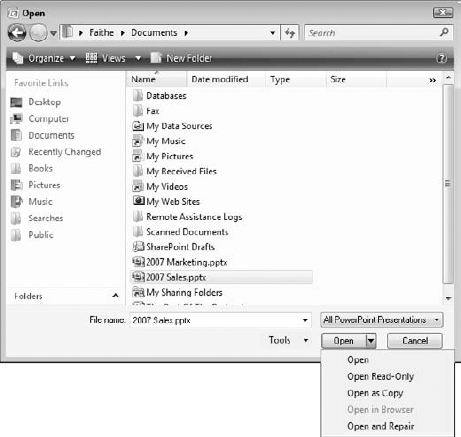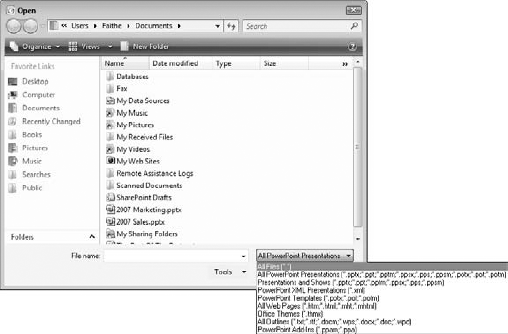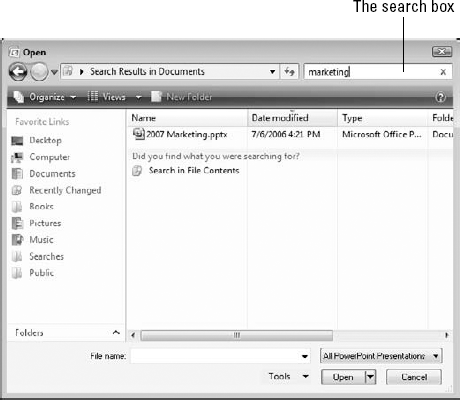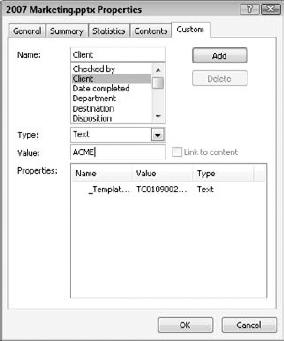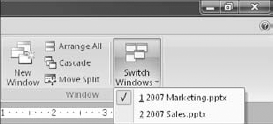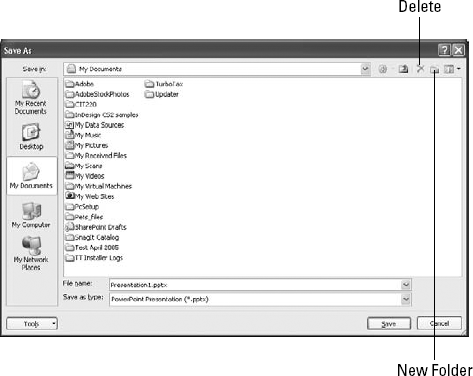If you're an experienced Windows and PowerPoint user, starting new presentations and saving files may be second nature to you. If so — great! You may not need this chapter. On the other hand, if you aren't entirely certain about some of the finer points, such as saving in different formats or locations, stick around.
Even people who consider themselves "advanced" users may benefit from this chapter, because it looks at some of the unique advanced saving features of Office applications and explains how to secure files with passwords.
You can start a blank presentation from scratch, or you can base the new presentation on a template or on another presentation. Using a template or existing presentation can save you some time. However, if you have a specific vision you're going for, starting a presentation from scratch gives you a clean canvas to work from.
When you start PowerPoint, a new blank presentation begins automatically with one slide. Just add your content to it, add more slides if needed, change the formatting (as you'll learn in upcoming chapters), and go for it.
If you need to start another blank presentation, follow these steps:
Choose Office

Blank Presentation is already selected. Click Create.
Tip
Press the Ctrl+N shortcut key to start a new presentation.
A template is a file that contains starter settings — and sometimes starter content — on which you can base new presentations. Templates vary in their exact offerings, but can include sample slides, a background graphic, custom color and font themes, and custom positioning for object placeholders.
When selecting a template, you can choose from these categories:
Installed Templates: Microsoft-provided templates that come preinstalled with PowerPoint.
My Templates: Templates that you have created and saved yourself and templates that you previously downloaded from Microsoft Office Online
Microsoft Office Online templates: Microsoft-provided templates that you download from Microsoft on an as-needed basis
Note
Also under Templates in figure 3.1 is Installed Themes. Themes are not exactly templates, but they are similar. Chapter 1 explained the difference. You can start a new presentation based on a theme as an alternative to using a template. Such a presentation starts with defined color, font, and effect settings.
There are only a few installed templates because Microsoft assumes that most people have an always-on Internet connection these days. Each installed template demonstrates a special-purpose type of presentation, such as a photo album, pitchbook, or quiz show. There is one Corporate Presentation template as well, but if you are interested in standard corporate presentation templates, you might prefer to look at the online offerings instead.
Follow these steps to start a presentation based on an installed template:
Choose Office

In the Templates list, click Installed Templates. A list of the installed templates appears.
Click a template to see a preview of it.
Select the template you want and click Create. A new presentation opens based on that template.
When you start a new presentation with an online template, as in the preceding section, PowerPoint copies that template to your hard disk so you can reuse it in the future without connecting to the Internet. It is stored, along with any custom template you have created, in the My Templates folder.
To access these downloaded and custom templates, follow these steps:
Choose Office

Click My Templates. A different New Presentation dialog box appears containing templates that you have downloaded or created. See figure 3.2.
Click OK. A new presentation opens based on that template.
Tip
Recently used template names appear on the right side of the New Presentation dialog box when it opens initially. You can select a template from there and click Create. To remove an item from the Recently Used Templates, right-click the item and choose Remove Item from List. To clear the whole list at once, right-click any entry and choose Remove All Items from List.
The bulk of the templates for presentations are available online. You can access the library of online templates without leaving PowerPoint. Follow these steps:
Choose Office

In the Templates list, in the Microsoft Office Online section, click the category of template you want. If you want standard business presentations, click Presentations; most of the other categories have special purposes.
Depending on the category you choose, a subcategory list might appear in the center pane. If it does, click the subcategory that you want.
Click a template to see a preview of it.
Select the template that you want and click Download. A new presentation opens based on that template.
Tip
Spend some time exploring the templates available on Microsoft Office Online. There's a lot here! For example, Design Slides has templates that don't contain any sample content — just design elements. This category has subcategories for earlier versions of PowerPoint, so if there was a particular design template you loved in, say, PowerPoint 2000, you can find it again here.
If you already have a presentation that's similar to the new one you need to create, you can base the new presentation on the existing one.
Follow these steps to use an existing presentation as a template:
Choose Office

Click New from Existing. The New from Existing Presentation dialog box opens. See figure 3.3.
Navigate to the location containing the existing presentation and select it. When you select a presentation, the Open button changes to a Create New button.
Click Create New.
PowerPoint can open files in several formats other than its own, so you can start a new presentation based on some work you have done elsewhere. For example, you can open a Word outline in PowerPoint. The results might not be very attractive — but you can fix that later with some text editing, slide layouts, and design changes.
To open a file from another application, do the following:
Choose Office

Click the File Type button (or Files of Type in Windows XP) and choose the file type. For example, to open a text file, choose All Outlines. See figure 3.4.
Select the desired file, and then click Open.
Save your work as a PowerPoint file by choosing File

Note
See the section "Saving Your Work" for more details on saving. You can also import a Word outline into an existing presentation.
PowerPoint is typical of most Windows programs in the way it saves and opens files. The entire PowerPoint presentation is saved in a single file, and any graphics, charts, or other elements are incorporated into that single file.
The first time you save a presentation, PowerPoint opens the Save As dialog box, prompting you for a name and location. Thereafter, when you save that presentation, PowerPoint uses the same settings and does not prompt you for them again.
If you haven't previously saved the presentation you are working on, Save and Save As do the same thing: They open the Save As dialog box. From there, you can specify a name, file type, and file location. Follow these steps:
Choose Office

Enter a filename in the File name box. See figure 3.5.
Note
In Windows Vista, the Save As dialog box does not show the existing content of the current location by default. To view it, click the Browse Folders arrow in the bottom-left corner of the dialog box.
Note
To save in a different location, see the section "Changing Drives and Folders." To save in a different format, see the section "Saving in a Different Format."
Click Save. Your work is saved.
Filenames can be up to 255 characters. For practical purposes, however, keep the names short. You can include spaces in the filenames and most symbols except <, >, ?, *, /, and . However, if you plan to post the file on a network or the Internet at some point, you should avoid using spaces; use the underscore character instead to simulate a space if needed. There have also been problems reported with files that use exclamation points in their names, so beware of that. Generally it is best to avoid punctuation marks in names.
Tip
If you want to transfer your presentation file to a different computer and show it from there, and that other computer does not have the same fonts as your PC, you should embed the fonts in your presentation so the desired fonts are available on the other PC. To embed fonts from the Save As dialog box, click the Tools button, choose Save Options, and mark the Embed Fonts in the File check box. This option makes the saved file larger than normal, so choose it only when necessary. For more information on advanced saving features, see the section "Specifying Save Options."
After you have once saved a presentation, you can resave it with the same settings (same file type, name, and location) in any of the following ways:
Choose Office

Press Ctrl+S.
Click the Save button on the Quick Access Toolbar.
If you need to save your presentation under a different name, as a different file type, or in a different location, use the Save As command instead. This reopens the Save As dialog box, as in the preceding steps, so that you can save differently. The originally saved copy will remain under the original name, type, and location.
Tip
If you frequently use Save As, you may want to place a button for it on the Quick Access Toolbar. To do this, right-click the Save As command and choose Add to Quick Access Toolbar.
By default, all files in PowerPoint (and all of the Office applications) are saved to the Documents folder (or My Documents under Windows XP) for the current user. Each user has his or her own version of this folder, so that each persons documents are kept separate depending on who is logged in to the PC.
The Documents folder is a convenient save location for beginners, because they never have to worry about changing the drive or folder. However, more advanced users will sometimes want to save files to other locations. These other locations can include floppy disks, other hard disks in the same PC, hard disks on other PCs in a network, hard disks on Web servers on the Internet, or writeable CDs.
Tip
Each user has a Documents or My Documents folder in his or her own profile. The actual location of that folder depends on the Windows version. For example, if Mary is logged in, the path would be C:UsersMaryDocuments. In Windows XP, the path would be C:Documents and SettingsMaryMy Documents. If your usual PowerPoint files seem to be missing at some point, make sure you are logged in under your usual username.
Throughout all of the Office programs, the dialog boxes that save and open files are different depending on the operating system you are using.
Windows Vistas Save As dialog box offers several alternatives for navigating between locations. Here's a summary:
Browse Folders: By default a compact version of the Save As dialog box appears, as in figure 3.5. To see the full version, as in figure 3.6, click the Browse Folders arrow.
Favorite Links list: This area displays shortcuts for popular locations such as Documents and Desktop. Double-click a shortcut here to jump to the desired location. This area does not appear unless Browse Folders is turned on.
Tip
Add your own favorite locations to the Favorite Links list by dragging their icons into the Favorite Links pane.
Folders list: This area displays a folder tree of locations, similar to the folder list in a Windows Explorer window. See figure 3.6. To display the Folders list if it does not already appear, click the up arrow to the right of Folders (below the Favorite Links list). To hide the Folders list, click the down arrow (which replaces the up arrow).
Tip
Drag the divider line between the Favorite Links and Folders lists to adjust their relative sizes. Drag the vertical divider line between them and the file listing to make the Favorite Links and Folders panes wider or narrower. You can also enlarge the whole Save As dialog box if needed by dragging its border.
Address bar: This area shows the path to the currently displayed location. You can jump directly to any of those levels by clicking the name there. This is similar to the "Up One Level" feature from Windows XP style dialog boxes except you are not limited to going up a single level at a time — you can go directly up to any level. You can also click the right-pointing arrow to the right of any level to see a menu of other folders within that location, and jump to any of them from the menu. See figure 3.7.
Under Windows XP, the Save In list shows the top-level locations on the system, including each drive, My Documents, and My Network Places. Open the list, as shown in figure 3.8, and select the location in which you want to start. Then double-click folder icons in the file listing to drill down to the location in which you want to save. To go back up one level, click the Up One Level button. See figure 3.8.

Figure 3.8. Select a top-level location from the Save In list and then double-click folders to work your way through to the desired location.
Along the left side of the Save As dialog box is the Places Bar. It's roughly equivalent to the Favorite Links list in Windows Vista. You can click a folder to jump to the desired location to save a file.
Tip
If you consistently want your PowerPoint files saved into a different folder, change the default file location. Choose Office
PowerPoint 2007 has a new XML-based file format, like the other Office 2007 applications. XML stands for eXtensible Markup Language; it is a text-based coding system similar to HTML that describes formatting by using inline bracketed codes and style sheets. XML-based data files are smaller than the data files from earlier PowerPoint versions, and they support all of the latest PowerPoint 2007 features. For best results, use this format whenever possible.
There are also several variants of this format for specialty uses. For example, there's a macro-enable version with a .pptm extension. There are also "show" variants (.ppsx and .ppsm) that open in Slide Show view by default, and template variants (.potx and .potm) that function as templates.
Tip
PowerPoint 2007 does not include macro recording functionality, so why is there a macro-enabled file format? It's because of Visual Basic for Applications (VBA). From the Developer tab, you can access a VBA editor, which lets you embed VBA code inside a PowerPoint presentation file (provided it is in a macro-enabled format).
However, not everyone has PowerPoint 2007, and only PowerPoint 2007 can open files with these new formats. (You can download a compatibility pack for earlier PowerPoint versions that will allow them to accept the new files, but you can't assume that everyone who has an earlier version of PowerPoint will download it.) Therefore you might need to save presentations in other file formats in order to share files with other people.
The available formats are shown in Table 3.1. In the Save As dialog box, open the Save as Type drop-down list and select the desired format. See figure 3.9.
Table 3.1. PowerPoint Save As Formats
Presentations: | ||||
|---|---|---|---|---|
Extension | Usage Notes | |||
PowerPoint Presentation | .pptx | The default; use in most cases. Can open only in PowerPoint 2007 (or on an earlier version with a conversion add-on installed). | ||
PowerPoint Macro-Enabled Presentation | .pptm | Same as above except it supports the storage of VBA or macro code. | ||
PowerPoint 97-2003 Presentation | .ppt | A backward-compatible format for sharing files with users of PowerPoint 97, 2000, 2002 (XP), or 2003. | ||
PowerPoint Template | .potx | A 2007-format template file. | ||
PowerPoint Macro-Enabled Template | .potm | A 2007-format template file that supports the storage of VBA or macro code. | ||
PowerPoint 97-2003 Template | .pot | A backward-compatible template file, also usable with PowerPoint 97, 2000, 2002 (XP), or 2003. | ||
PowerPoint Show | .ppsx | Just like a regular PowerPoint file except it opens in Slide Show view by default; useful for distributing presentations to the audience on disk. | ||
PowerPoint Macro-Enabled Show | .ppsm | Same as above except it supports the storage of VBA or macro code. | ||
PowerPoint 97-2003 Show | .pps | Same as a regular backward-compatible presentation file except it opens in Slide Show view by default. | ||
PowerPoint XML Presentation | .xml | A presentation in XML format, suitable for integrating into an XML information storage system. | ||
Single File Web Page | .mht, .mhtml | A complete presentation stored in a single file that can be displayed in most modern Web browsers. Suitable for posting on a Web site or sending via e-mail. | ||
Web Page | .htm, .html | A typical text HTML file with each graphic element in a separate file. Suitable for posting on a Web site. | ||
Graphics/Other: | ||||
Format | Extension | Usage Notes | ||
Produces files in Adobe PDF format, which is a hybrid of a document and a graphic. It shows each page exactly as it will be printed, and yet allows the user to mark up the pages with comments and to search the document text. Available only after downloading PDF and XPS support from Office Online. You must have a PDF reader such as Adobe Acrobat to view PDF files. | ||||
.xps | Much the same as PDF except it's a Microsoft format. Windows Vista comes with an XPS viewer application. | |||
Office Theme | .thmx | Somewhat like a template, but it contains only theme settings (fonts, colors, and effects). Use this if you want to apply the colors, fonts, and effects from the current presentation to other presentations but you don't want to save any of the content or layout. | ||
PowerPoint Add-In | .ppam | A file containing executable code (usually VBA) that extends PowerPoint's capabilities. | ||
PowerPoint 97-2003 Add-In | .ppa | Same as above except the add-in is backward-compatible. | ||
GIF Graphics Interchange Format | .gif | Static graphic. GIFs are limited to 256 colors. | ||
PNG Portable Network Graphics Format | .png | Static graphic. Similar to GIF except without the color depth limitation. Uses lossless compression; takes advantage of the best features of both GIF and JPG. | ||
JPEG File Interchange Format | .jpg | Static graphic. JPG files can be very small, making them good for Web use. A lossy format, so picture quality may not be as good as with a lossless format. | ||
TIFF Tagged Image File Format | .tif | Static graphic. TIF is a high-quality file format suitable for slides with high-resolution photos. A lossless compression format. | ||
Device Independent Bitmap | .bmp | Static graphic. BMP is the native format for Windows graphics, including Windows background wallpaper. | ||
Windows Metafile | .wmf | Static graphic. A vector-based format, so it can later be resized without distortion. Not Mac-compatible. | ||
Enhanced Windows Metafile | .emf | Enhanced version of WMF; not compatible with 16-bit applications. Also vector-based and non-Mac-compatible. | ||
Outline/RTF | .rtf | Text and text formatting only; excludes all non-text elements. Only text in slide placeholders will be converted to the outline. Text in the Notes area is not included. | ||
Tip
If you consistently want to save in a different format from PowerPoint 2007, choose Office
Table 3.1 lists a lot of choices, but don't let that overwhelm you. You have three main decisions to make:
PowerPoint 2007 format or backward-compatible with PowerPoint 97-2003. Unless compatibility is essential, go with the 2007 format because you get access to all of the new features. (See Table 3.2 to learn what you'll lose with backward-compatibility) If you use a backward-compatible format, some of the features described in this book work differently or aren't available at all.
Macro-enabled or not. Most people will never need to create a macro-enabled presentation. PowerPoint 2007 does not support macro recording, so the only macros you would have would be written in VBA, and most PowerPoint users aren't fluent in VBA programming.
Regular presentation or PowerPoint Show. The "show" variant starts the presentation in Slide Show view when it is loaded in PowerPoint; that's the only difference between it and a regular presentation. You can build your presentation in a regular format, and then save in show format right before distribution.
Most of the other choices from Table 3.1 are special-purpose and not suitable for everyday use. The following sections explain some of those special types.
Table 3.2. PowerPoint 2007 Features Not Supported in Previous PowerPoint Versions
Feature | Issues |
|---|---|
SmartArt Graphics | Converted to uneditable pictures |
Charts (except Microsoft Graph charts) | Converted to editable OLE objects, but the chart might appear different |
Custom Slide Layouts | Converted to multiple masters |
Drop Shadows | Soft shadows converted to hard shadows |
Equations | Converted to uneditable pictures |
Heading and body fonts | Converted to static formatting |
New effects:
| Converted to uneditable pictures |
Converted to styles | |
Theme colors | Converted to styles |
Theme effects | Converted to styles |
Theme fonts | Converted to regular font usage |
To share your presentation on the Web with people who don't have PowerPoint, you can save in one of the Web Page formats.
You have two choices for Web format: Web Page or Single File Web Page. Web Page creates an HTML document that has links to the slides, and then the slides and their graphics are stored in a separate folder. This would be suitable for posting on a Web site. Single File Web Page creates a single .mht document that contains all of the HTML codes and all of the slides. This would be suitable for e-mailing, for example. (In fact, the "M" in the name format is short for "mail," because this format was originally designed for e-mail use.) However, with both of these Web formats, you lose some of the special effects, so you might prefer to distribute the presentation in a different way on the Web. If keeping the full effect of all the effects is important, consider saving in one of the PowerPoint Show formats and then make the PowerPoint Viewer utility available for free download from the same Web page.
Note
See Chapter 22 for details about the PowerPoint Viewer.
If you save your presentation in one of the graphic formats shown in the Graphics/Other section of Table 3.1, the file ceases to be a presentation and becomes a series of unrelated graphic files, one per slide. If you choose one of these formats, you're asked whether you want to export the current slide only or all slides. If you choose all slides, PowerPoint creates a new folder in the selected folder with the same name as the original presentation file and places the graphics files in it.
If you want to export the text of the slides to some other application, consider the Outline/RTF format, which creates an outline similar to what you see in the Outline pane in PowerPoint. This file can then be opened in Word or any other application that supports RTF text files. Only text in placeholders is exported, though, not text in manually inserted text boxes.
The Save Options enable you to fine-tune the saving process for special needs. For example, you can employ Save Options to embed fonts, to change the interval at which PowerPoint saves AutoRecover information, and more.
There are two ways to access the Save options:
Choose Office

From the Save As dialog box, click Tools

The PowerPoint Options dialog box appears, as in figure 3.10.
Then set any of the options desired. They are summarized in Table 3.3. Click OK when you are finished.
One of the most important features described in Table 3.3 is AutoRecover, which is turned on by default. This means if a system error or power outage causes PowerPoint to terminate unexpectedly, you do not lose all of the work you have done. The next time you start PowerPoint, it opens the recovered file and asks if you want to save it.
Warning
AutoRecover is not a substitute for saving your work the regular way. It does not save in the same sense that the Save command does; it only saves a backup version as PowerPoint is running. If you quit PowerPoint normally, that backup version is erased. The backup version is available for recovery only if PowerPoint terminates abnormally (because a system lockup or a power outage, for example).
Table 3.3. Save Options
Feature | Purpose |
|---|---|
Sets the default file format to appear in the Save As dialog box. Your choices are a regular presentation, a macro-enabled presentation, or a 97-2003 backward-compatible presentation. | |
Save AutoRecover info every ___ minutes | PowerPoint saves your work every few minutes so that if the computer has problems and causes PowerPoint to terminate abnormally, you do not lose much work. Lower this number to save more often (for less potential data loss) or raise it to save less often (for less slowdown/delay related to repeated saving). |
Default file location | Specify the location that you want to start from when saving with the Save As dialog box. By default it is your Documents (or My Documents) folder. |
Save Checked-Out Files To | Sets the location in which any drafts will be saved that you have checked out of a Web server library such as SharePoint. If you choose The Server Drafts Location on This Computer, then you must specify what that location will be in the Server Drafts Location box. If you choose to save to The Web Server, it's not an issue because every save goes immediately back to the server. |
Preserve Fidelity When Sharing This Presentation | This drop-down list enables you to select from among all the open presentation files for the following setting to affect. |
Embed Fonts in the File | Turn this on if you are saving a presentation for use on a different PC that might not have the fonts installed that the presentation requires. You can choose to embed the characters in use only (which minimizes the file size, but if someone tries to edit the presentation they might not have all of the characters out of the font that they need), or to embed all characters in the font set. Unlike the others, this setting applies only to the current presentation file. |
If a presentation contains sensitive or confidential data, you can encrypt the file and protect it with a password. Encryption is a type of "scrambling" done to the file so that nobody can see it, either from within PowerPoint or with any other type of file-browsing utility
You can enter two separate passwords for a file: the Open password and the Modify password. Use an Open password to prevent unauthorized people from viewing the file at all. Use a Modify password to prevent people from making changes to the file.
You can use one, both, or neither of the password types. For example, suppose you have a personnel presentation that contains salary information. You might use an Open password and distribute that password to a few key people in the Human Resources department who need access to it. But then you might use a Modify password to ensure that squf of those people make any changes to the presentation as they are viewing it.
For the Open password, you can specify an encryption method and strength. Many encryption codes are available, and the differences between them are significant mostly to high-end technical users. However, if you do have a preference, you can choose it when you choose the Open password.
To manage a file's passwords and other security settings, do the following:
Save the file as you normally would from the Save As dialog box.
Click Tools, and choose General Options. The General Options dialog box opens. See figure 3.11.
If you want an Open password, enter it in the Password to Open box.
If you want a Modify password, enter it in the Password to Modify box.
(Optional) If you want your personal information stripped from the file, such as your name removed from the Author field of the Properties box, mark the Remove Automatically Created Personal Information from This File On Save check box.
(Optional) If desired, adjust the macro security level for PowerPoint (all files, not just this one) by clicking the Macro Security button and making changes to the settings in the Trust Center; then click OK to return to the General Options dialog box.
Click OK.
If you specified a password in step 3, a confirmation box appears for it. Retype the same password and click OK.
If you specified a password in step 4, a confirmation box appears for it. Retype the same password and click OK.
Continue saving normally.
When you (or someone else) open the file, a Password prompt appears. The Open password must be entered to open the presentation file. The Modify password will not work. After that hurdle, if you have set a separate Modify password, a prompt for that appears. Your choices are to enter the Modify password, to cancel, or to click the Read Only option to open the presentation in Read Only mode.
You can have several presentation files open at once and switch freely between them, but this can bog down your computer's performance somewhat. Unless you are doing some cut-and-paste work, it's best to have only one presentation file open — the one you are actively working on. It's easy to close and open presentations as needed.
When you exit PowerPoint, the open presentation file automatically closes, and you're prompted to save your changes if you have made any. If you want to close a presentation file without exiting PowerPoint, follow these steps:
Choose Office

If you have not made any changes to the presentation since the last time you saved, you're done.
If you have made any changes to the presentation, you're prompted to save them. If you don't want to save your changes, click No, and you're done.
If you want to save your changes, click Yes. If the presentation has already been saved once, you're done.
If the presentation has not been saved before, the Save As dialog box appears. Type a name in the File Name text box and click Save.
To open a recently used presentation, select it from the right side of the Office menu. Although only one file appears in figure 3.12, up to nine can appear by default.
Tip
To pin a certain file to the Office menu's list so that it never scrolls off, click the pushpin icon to the right of the file's name on the menu. You can increase or decrease the number of recently used files that appear on the Office menu. Choose Office
If the presentation you want to open does not appear on the Office menu, follow these steps to find and open it:
Choose Office

Choose the file you want. If necessary, change the location to find the file.
Note
See the section "Changing Drives and Folders" earlier in this chapter if you need help.
Click Open. The presentation opens.
To open more than one presentation at once, hold down the Ctrl key as you click each file you want to open. Then, click the Open button and they all open in their own windows. For more information, see the "Working with Multiple Presentations" section later in this chapter.
The Open button in the Open dialog box has its own drop-down list from which you can select commands that open the file in different ways. See figure 3.13, and refer to Table 3.4 for an explanation of the available options.
Table 3.4. Open Options
Open Button Setting | Purpose |
|---|---|
Open | The default, simply opens the file for editing. |
Open Read-Only | Allows changes but prevents those changes from being saved under the same name. |
Open Copy | Opens a copy of the file, leaving the original untouched. |
Applicable only for Web-based presentations, opens it for viewing in a Web browser. | |
Open and Repair | Opens the file, and identifies and repairs any errors it finds in it. |
Show Previous Versions | Applicable only if the presentation file is stored on an NTFS volume under Windows Vista. See the next section for details. |
Just as you can save files in various program formats, you can also open files from various programs. PowerPoint can detect the type of file and convert it automatically as you open it, so you do not have to know the exact file type. (For example, if you have an old PowerPoint file with a .ppt extension, you don't have to know what version it came from.) The only problem is with files that don't have extensions that PowerPoint automatically recognizes. In that case, you must change the File Type setting in the Open dialog box to All Files so that the file to be opened becomes available on the file list. See figure 3.14. This change is valid for only this one use of the Open dialog box; the file type reverts to All PowerPoint Presentations, the default, the next time you open it.
Warning
PowerPoint opens only presentation files and text-based files such as Word outlines. If you want to include graphics from another program in a PowerPoint presentation, copy- and-paste them into PowerPoint or insert them using the Picture command on the Insert tab. Do not attempt to open them with the Open dialog box.
If you have forgotten where you saved a particular presentation file, you're not out of luck. The Open dialog box (under Windows Vista) includes a Search box that can help you locate it. See figure 3.15.
To search for a file, follow these steps:
Choose Office

Navigate to a location that you know the file is in. For example, if you know it is on the C: drive, click Computer in the Favorite Links list and then double-click the C: drive.
Click in the Search box and type part of the filename (if you know it) or a word or phrase used in the file.
Press Enter. A list of files appears that match that specification.
Open the file as you normally would.
Note
You can also use the Search utility from outside of PowerPoint. In Windows, click Start and choose Search. Although the Search utility in Windows Vista is different from the one in Windows XP, both can find a file by name, content, author, date, or many other properties.
File properties are facts about each file that can help you organize them. If you have a lot of PowerPoint files, using file properties can help you search intelligently for them using the Search feature you learned about in the preceding section. For example, you can specify an author, a manager, and a company for each file, and then search based on those values.
You can set a file's properties while it is open in PowerPoint by doing the following:
Choose Office

Fill in any information you want to store about the presentation. See figure 3.16.
Click the down arrow to the right of Standard in the Properties ribbon, and choose Advanced Properties. The Properties dialog box for the file appears.
Click the Summary tab, and confirm/change any information there. This is the same information that you entered in the Properties ribbon, with the addition of a couple of other fields. See figure 3.17.
Click the Custom tab, shown in figure 3.18, and choose any additional fields you need and set values for them. For example, click the Client field on the Name list, and type a value for it in the Value text box. Repeat this for any of the other custom fields.
Review the information on the Statistics and Contents tab if desired. (You can't change that information.)
Click OK.
Now you can use the contents of the properties fields when performing a search.
To save yourself some time, you can perform certain file management tasks without leaving PowerPoint. Any dialog box that enables you to select a file to open — such as the Open dialog box— or enables you to save a file — such as the Save As dialog box— can also be used to copy, delete, and rename files.
When saving files, you might want to create a new folder to put them in. To create a new folder in a Windows Vista style dialog box, click New Folder in the command bar. See figure 3.19. To create a new folder in Windows XP, click the New Folder button in the row of buttons that appears across the top of the Save As dialog box. See figure 3.20.
One way to copy a presentation is to open it and then save it under a different name. (You learned to do this earlier in this chapter.) But here's a method that enables you to copy without having to first open the file:
From the Open dialog box, select the file you want to copy. (You can also use the Save As dialog box if you enable Browse Folders so you see the file listing.)
Right-click the file and choose Copy from the shortcut menu.
If necessary, change to a different drive and/or folder.
Choose Paste from the shortcut menu. The file appears. If you pasted it into the same folder as the original, the new one has the words Copy of at the beginning of its name to differentiate it. Rename it if desired.
Note
For more on renaming, see the section "Renaming a Presentation" later in this chapter.
Click Cancel to close the dialog box.
Just as you can copy a file, you can delete a presentation file from Windows itself, bypassing PowerPoint altogether. Just select the file in Windows Explorer or My Computer and press the Delete key, or drag it to the Recycle Bin on the Windows desktop.
To delete a file from within PowerPoint, select it from the Save As or Open dialog box and press the Delete key on the keyboard or right-click it and choose Delete. (Or in a Windows XP style dialog box, you can click the Delete button on the toolbar.) You cannot delete a file that is currently open.
Note
If you accidentally delete a file, you can get it back if you deleted from Windows; just open the Recycle Bin and drag it back out.
To rename a file from within the Save As or Open dialog boxes, click it, and then press F2, or right-click it and choose Rename from the shortcut menu. Then type the new name and press Enter.
If you have the display of file extensions for known file types turned off in Windows (the default), you do not need to type the .pptx extension when renaming files. In fact, if you do type it, the file may end up with a double extension, like myfile.pptx.pptx. On the other hand, if you have the display of file extensions turned on, you must type the file extension while renaming a file.
Tip
To change the setting that governs whether or not file extensions are displayed, open the Computer window in Windows Vista and choose Organize
This assigns a drive letter to a folder on a remote PC. This might be useful if you save frequently to a network location and you don't want to have to wade through multiple levels of folders each time to find it. (But you can also accomplish the same thing by creating a shortcut in My Network Places.)
To map the currently displayed folder as a network drive, open the Tools menu from either the Open or Save As dialog box and choose Map Network Drive. This opens a dialog box that lets you associate a drive letter with the location.
This chapter made you a master of files. You can now confidently create new presentations, and save, open, close, and delete PowerPoint presentation files. You can also save files in different formats, search for missing presentations, and lots more. This is rather utilitarian knowledge and not very much fun to practice, but later you will be glad you took the time to learn it, when you have important files you need to keep safe.
In the next chapter, you learn about slide layouts and text-based presentations. You also learn how to create your own layouts, and how to use the Outline pane to create the text that will form the basis of your message.
